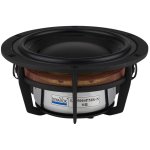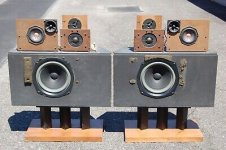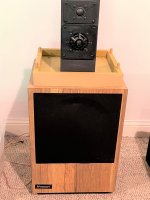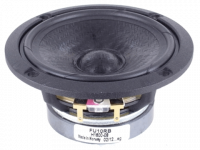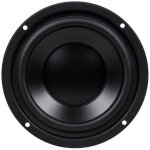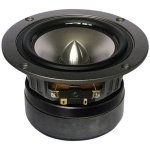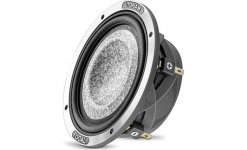Yeah, for example 200Hz is ~1.7m long and if enclosure dimensions is even half this let alone few tens of centimeters there is not much diffraction happening no matter what the shape, as its acoustically relatively small. Conversely, if speaker is big enough to introduce diffraction on hundreds of Hertz it needs huge roundovers (huge sphere) to mitigate. Its all relative to wavelength.
Or, as sphere doesn't diffract much at all it doesn't matter what size it is, it just doesn't diffract as long as there is "no edge". I mean if the enclosure sphere diameter is roughly smaller than 2x driver diameter the driver makes a "flat slice" on the sphere and some diffraction happens at driver edge. How mucho this is of a concern is up to the builder but its easy to figure out in simulation.
Here is quickie, driver radius is 80mm and if add round baffle with 80mm roundover for it diffraction is almost gone, only mild hump seen.
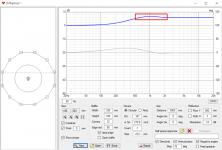
Or the other way around, when edge round over radius is same as baffle radius then the diffraction is gone in simulator, a sphere, but as soon as the "flat part" driver is introduced on it some mild hump appears until the sphere is quite large. There is still mild hump even if the sphere diameter is about 3x the driver diameter.
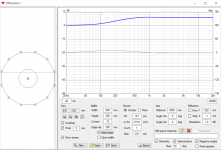
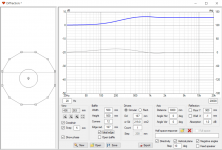
And one can make it square to have similar performance as long as the round over is big enough, as big as possible = starts immediately at the driver edge, and diffraction is minimized.

And from this there is rule of thumb that the structure needs to approximate a sphere as well as possible for the wavelength to get rid of diffraction.
Or, as sphere doesn't diffract much at all it doesn't matter what size it is, it just doesn't diffract as long as there is "no edge". I mean if the enclosure sphere diameter is roughly smaller than 2x driver diameter the driver makes a "flat slice" on the sphere and some diffraction happens at driver edge. How mucho this is of a concern is up to the builder but its easy to figure out in simulation.
Here is quickie, driver radius is 80mm and if add round baffle with 80mm roundover for it diffraction is almost gone, only mild hump seen.

Or the other way around, when edge round over radius is same as baffle radius then the diffraction is gone in simulator, a sphere, but as soon as the "flat part" driver is introduced on it some mild hump appears until the sphere is quite large. There is still mild hump even if the sphere diameter is about 3x the driver diameter.


And one can make it square to have similar performance as long as the round over is big enough, as big as possible = starts immediately at the driver edge, and diffraction is minimized.

And from this there is rule of thumb that the structure needs to approximate a sphere as well as possible for the wavelength to get rid of diffraction.
Last edited:
If you don't see it in these sims, doesn't mean diffraction isn't happening. Responses are not good at showing it.
Wiggle in the frequency response plot is due to secondary sound source forming at the baffle edge. Part of sound from the driver goes around the edge and part reflects backwards opposite phase. As wavelength gets longer all of the sound goes around the edge and no backwave emits, no secondary sound source. Baffle step. There is the "main diffraction hump" at top of the bafflestep, roughly at and below baffle dimension wavelength but soon below that there is less and less until at some point there is none. Frequency response plot is good way to evaluate "amount of diffraction", get the wiggle +/-1db and you have ~-20db off edge diffraction in comparison to direct sound which equals ~10% of linear distortion.
Here the above example again, 50cm baffle with and without roundover, about worst possible diffraction happens on such baffle as distance from the source to edge is constant all around. 50cm is ~700Hz and two octaves below ~150Hz there is still some boost from diffraction (or baffle support, what ever) but not much anymore.
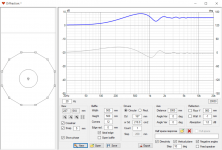
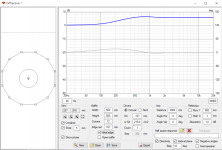
Here, quick test shows that signal attenuated 20db makes +/-1db interference.
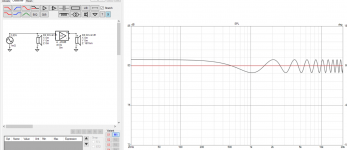
To get to 1% relative level the interference needs to disappear, a sphere.
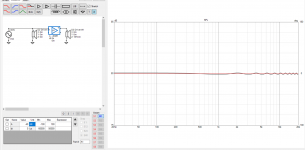
Here the above example again, 50cm baffle with and without roundover, about worst possible diffraction happens on such baffle as distance from the source to edge is constant all around. 50cm is ~700Hz and two octaves below ~150Hz there is still some boost from diffraction (or baffle support, what ever) but not much anymore.


Here, quick test shows that signal attenuated 20db makes +/-1db interference.

To get to 1% relative level the interference needs to disappear, a sphere.

Last edited:
Another interesting vid by the chief speaker designer at PS Audio about human hearing and whether physical phase / time alignment works (or not) relative to what we can hear.
And one that argues electronic phase shift in speakers (from xovers and amps) is not really audible other than in anechoic chambers - with all the reflections in typical listening rooms. Essentially you get "phase soup" but fortunately the human ear is not sensitive to sound differences below about 40 milliseconds.
https://www.jstage.jst.go.jp/article/ast/23/1/23_1_1/_pdf/-char/en"the human auditory system is sensitive to the difference between zero and nonzero phase."
https://www.researchgate.net/publication/352265058_Audibility_of_Group-Delay_Equalization
"The results indicate that the audibility thresholds for local group-delay variation are less than ±1 ms for the most critical signals, and approximately 1.5 ms to 4.5 ms for a local positive group-delay peak and between −1.0 ms and −2.3 ms for a local negative group-delay peak for real-life signals. In the present study, just like in multiple earlier studies, the impulse-like signals resulted in the lowest threshold values. However, the thresholds obtained in this work for the impulsive signals are considerably smaller than those reported earlier. The thresholds found in our study for the real-life signals were either the same or slightly higher than the ones reported in other studies. This study reports also the audibility of the negative group delay and finds this to be slightly more audible than a positive group delay. Earlier studies have primarily focused on the positive group delay alone.
You're making assumptions about what you see without evidence.
What? You should search for your self and do the tests if you don't believe what you see and read here. The simulator is based on math which is based on reality in high enough accuracy to approximate what measurements would show, speed of sound as the constant making wavelength and rest is just algorithm spitting out results. Sure the model is simplified as its the front edge only and even that is simplified but anything that happens behind the box is attenuated already so the effect is small in comparison and the front edge simulation is suitable enough to evaluate performance on this level I'm representing it.
You could go deeper into it, to molecular level how the diffraction happens if you want to, impedance change and all, maths, 3D, but it is not necessary. All we need to know what the implications are and the simulation is showing them perfectly fine as graphs with very little effort. It takes much longer to write on the forum than make observations from real time simulations. I encourage you to play with it and present your observations here, or any other knowledge on the subject as I would be happy if you could help me and others to get more accurate information to make better speakers.
What is missing from the simulation result and my observations is how it all sounds, how to relate graphs to sound at our own listening situation, does any of it matter or not.
Last edited:
For oon-the-kid, You have to make every effort IMO in that scenario to have as much mid as possible not come from the woofer where you can get both enclosure and cone diffraction effects. So crossover as low as possible. The mid woofer offers a good approach. I used this one in a recent build...it goes pretty flat to 100Hz and can take a 12db xover down from there, and then go to a sub for the lower bass. The Dynavox attached features a 3 inch coil in a 5 1/2" driver so that the mids are basically coming off of the dome and dispersing rather than diffracting. It also goes out nicely to about 4,000-5,000 Hz so you can xover at 12 db at 2,000, and then go to a larger tweeter capable of coming down to 2,000 with decent power handling ability. With this mid, all of the primary vocal range comes off of one driver that is not a traditional cone. Regular dome mids, which I like, even a 3 incher, usually have to be crossed by not lower than 500 Hz so you split the vocal range across two drivers.
Woofers in cylinders are difficult as you need a big dia. tube for say even an 8 inch.
Woofers in cylinders are difficult as you need a big dia. tube for say even an 8 inch.
Attachments
"What is missing from the simulation result and my observations is how it all sounds, how to relate graphs to sound at our own listening situation, does any of it matter or not."
One of the ways to hear what diffraction does is to build two enclosures with the same internal volume for the woofers, same drivers and xovers, one - a more traditional box - and the other a sphere (or 2 more more spheres like the Envy 3). You can make sure all the "ingredients" are what you like (including any phase corrections et al). Then blind A-B them at the same db and in the same room and positional location. What you hear will be quite enlightening. The openness and soundstage are very noticeable. I won't call diffraction "distortion" per se as it is a perceived change in tonality and sound space, falling into psycho-acoustic territory as well.
I first did this back in the late 70s when building box speakers with larger woofers, and dome mids and tweeters. The Dahlquist DQ 10s were introduced in the 70s and had smaller baffles on their mids and tweeters than typical for the day (although they are more than you'd want today). There were 4 of them so it's a complex design. But the sales guy at the high end audio store made the comment on how they sounded more open than other speakers, and to me they sure did. For me it was "wow". So I bought more of the same woofers, mids and tweeters I had used in my boxes, and simply enclosed the woofer in the second test speaker and put a small rack on top to mount the mid and tweeter on each (see photo), They were sealed domes so basically I wanted to "suspend" them in "free air" as much as possible. A Peerless K010DT 1" fabic dome (used in Polk speakers) and a 2" midrange fabric dome (used by KLH at the time). There are of course better drivers today. But the sound was remarkably different, same everything else except the mid and tweeter mounted out in the open (except today I might perhaps place the rack farther forward and maybe a bit higher up). Then covered the top with a screen for aesthetics.
One of the ways to hear what diffraction does is to build two enclosures with the same internal volume for the woofers, same drivers and xovers, one - a more traditional box - and the other a sphere (or 2 more more spheres like the Envy 3). You can make sure all the "ingredients" are what you like (including any phase corrections et al). Then blind A-B them at the same db and in the same room and positional location. What you hear will be quite enlightening. The openness and soundstage are very noticeable. I won't call diffraction "distortion" per se as it is a perceived change in tonality and sound space, falling into psycho-acoustic territory as well.
I first did this back in the late 70s when building box speakers with larger woofers, and dome mids and tweeters. The Dahlquist DQ 10s were introduced in the 70s and had smaller baffles on their mids and tweeters than typical for the day (although they are more than you'd want today). There were 4 of them so it's a complex design. But the sales guy at the high end audio store made the comment on how they sounded more open than other speakers, and to me they sure did. For me it was "wow". So I bought more of the same woofers, mids and tweeters I had used in my boxes, and simply enclosed the woofer in the second test speaker and put a small rack on top to mount the mid and tweeter on each (see photo), They were sealed domes so basically I wanted to "suspend" them in "free air" as much as possible. A Peerless K010DT 1" fabic dome (used in Polk speakers) and a 2" midrange fabric dome (used by KLH at the time). There are of course better drivers today. But the sound was remarkably different, same everything else except the mid and tweeter mounted out in the open (except today I might perhaps place the rack farther forward and maybe a bit higher up). Then covered the top with a screen for aesthetics.
Attachments
‘ some of this is trying to spitball or lean towards something in an effort Get smarter people than myself or people of other areas of expertise/experience/ fields of study or academics that would add more to it and further it.
Otherwise it can immediately be argued at face value if not realizing that. I’m not trying to argue anything, or trying to say that I have a solution to some kind of problem or that . I try to hint at something very very real that’s got so many incredible and unrecognized things to look at about it already that are almost ludicrous where they’re hiding but never should have been in units of measure details etc. very awkward and suspicious even…?’
The numbers in square root of numbers and the numbers that describe in centimeters converted to an inch overlap numbers that represent numbers are trigonometry but also that are in frequencies which will continue in a variety of ways but the numbers are a little bit different looking in the ways they have been smeared all over into various descriptions all of which come full circle no pun intended?
as a shape a sphere is obvious. On the inside of a rectangle not so much. What we perceive and what happens in reality or in math or however you wanna try to figure things out by measuring and testing for math and then experimenting to ensure the math is correct and of course math is always slightly wrong reality is just another set of greater conditions that you didn’t get to that detail in your math…
The idea of a rectangle being two cubes and the fact that his steer has a volumetric ration related to that cube which then also drops into the equation or representation of a pendulum swing at the gravitational constant presence at the equator or combine to itThe idea of a rectangle being two cubes and the fact that his steer has a volumetric ration related to that cube which then also drops into the equation or representation of a pendulum swing at the gravitational constant presence at the equator or combine to something above and beyond anything else initially.
you have the generic roots and concepts that branch out into everything else from the fact that everything is vibrating oscillating and producing the math equivalent of a sine wave or similar in the variety of ways we can even more specifically break that apart or multidimensionally add more relevant information to it.
but you can take anything and figure out how it’s maxed out or representing a sine wave. After all the diameter of a cm Drop of water on a flat surface as well as the kilogram and the liter if 1000 of them. Cm is 864 Hz, and the 1 m long pendulum is 39.37”. And that’s one second and 30° or half a second and 15 of its definition of frequency in cycle.
Going deeper into what is used to describe 30° you realize it’s slightly less than 30° as 12 on 6.9375 shows up as radians or degrees in the construction trades and drafting etc. 60 off of 90 as well.
i’m not quite 30° three is not quite 3. Completely and totally overlooked all day every day and so are the decimals of a centimeter conversion to an inch yet there’s a whole incredible amount of information there already in those decimal points and while that detail doesn’t matter or ever would even at the space shuttle launching level but it did bite us in the *** once already for the same reason in the conversions between inch in centimeters or kilometer and mile where you could bump into the golden ratio or you could bump into this erroneous thing and I never system already that’s been a problem with the speed of light and it’s definition, Second and the meter as well.
Still the problem it’s still in everything and it always will be because Summers down the road that is time dilation or what inevitably be that with further application using the triangles in the Pythagorean theorem or even those same things placed on a sphere where they were king at somewheres and never lie flat just like a ribbon wrapped around the equator of a global sphere well no matter what drift towards a pole because it has to cannot be perfectly centered on the equator. The most infinitely small and impossible string good and planks cottoThe most infinitely small and impossible string good and planks constant Still isn’t enough until you actually use it and consider magnetic force is not the simple terms that we are always thinking and shapes and bending things around corners that already exist not just the cornerStill isn’t enough until you actually use it and consider magnetic force is not the simple terms that we are always thinking and shapes and bending things around corners that already exist. The corners and things that we can’t comprehend because they’re magnetic not visible light or they can’t the concept we’re used to using to envision how things work.
Gravity is not anything you could touch feel or even see but in math we can look at it exactly on any car it’s practically the top bell housing bolts of the transmission. All suspension can pivot off of that and the math away from it.
The same thing could be done in using a circle and where a speaker driver sits inside as well.
you can put everything into the context of a circle° of a circle matched up to centimeters is convenient as heck to make this easier it also falls into the area of subwoofers that work for us.
Forever what’s inconvenient or what doesn’t turn out it’s a bad reputation because it was only as far as we could look at it and see and the majority is always wrong and evolution has always created the next Norm from the weirdest and most awkward previous thing it seems?
Hubble constant has got a problem so James Webb telescope is up in the air the universe and infinity have essentially been explained and thoroughly understood from a visible light and Big Bang number and expanded universe perspective but there’s more to it something is not working and it’s a percentage of dark matter compared to the percentage of what we exist in that is grossly disproportion and creating things like Jupiter creates to the solar system and the sun and then beyond Neptune Pluto is a repeat of something that happens as well and voyager space probe from the 70s has recently gone through that area itself.
These things are already in the frequencies and things associated with these higher order and closures or the special types of portal with transmission lines with an officer driveThese things are already in the frequencies and things associated with these higher order and closures or the special types of portal with transmission lines with an offset enryy.
nunvers specific to that, in greater detail than what is just typically a generic concept from antenna theory go on to explain the connection between all of this stuff.
If you looked into that and for whatever reason dropped the current method of thinking or simply were incredibly curious so that you could see something instead of having missed it like we all have for ever, The direct connection to the golden ratio and another ratio that’s representative a bit but that rules the entire universe and likely is what created the golden ratio and all that stuff already. The cubed root versus its opposite on the other side of one of these things like Euler’s number and what have you are all in transmission line entry, exitand separations from drivers and closed in at all these things that nobody looks into the details and realizes. It’s a fluke it’s a coincidence or whatever but horn response open that door just a half a year ago at most it’s in the section labeled ‘PHi’ ironically but absolutely perfect. Almost as if it was supposed to be that way Mr. McQueen has been planning it all along to slowly allow us but not at an excessive pace to discover things along the way if we chose to.
Whatever he has up his sleeve it’s never disappointed it’s always creating opportunities like nothing else as soon as you realize garbage in garbage out and then be careful what you’re doing and theWhatever he has up his sleeve it’s never disappointed it’s always creating opportunities like nothing else as soon as you realize garbage in garbage out and then be careful what you’re doing. We can’t smash things together and summarize everything in the limited inputs are available to use at the same time the limitation of those lends itself to restricting us for going off on tangents in detail that would never matter and could’ve been not used or not confused anyhow?
If it was up to me everything will be as exciting as making a horn sheeIf it was up to me everything will be as exciting as making a horn shape. And no matter what even the gigantic ones and have this perfect impedance matching crazy awesomeness based solely on the fact that every one and everything perceives and concludes that that is definitely awesome at the same time it works great as a guide on the TwitteAnd no matter what even the gigantic ones and have this perfect impedance matching crazy awesomeness based solely on the fact that every one and everything perceives and concludes that that is definitely awesome at the same time it works great as a guide on the Tweeter , but in the subwoofer there’s already a version of something else to look at and whether or not we want to make a horn it’s simply impossible for 99.9% of us to make a real one at those frequencies and maybe that’s for a reason?
As a sphere you’re focusing in on something that has little attributes otherwise and quite possibly getting up on whatever is else that that will not allow.
The exterior shape and edge defraction Obviously something a benefit but no matter what there is a bunch of rectangles that need everyone’s undivided attention at all times with parallel perfect tens which once all arranged there is a reasonable small amount of stuffing and open cell foam that take care of the rest but there’s not much to take care of if you get it just right it’s all little tiny details that we’re going to be there no matter what is high frequency black junObviously something a benefit but no matter what there is a bunch of rectangles that need everyone’s undivided attention at all times with parallel perfect tens which once all arranged there is a reasonable small amount of stuffing and open cell foam that take care of the rest but there’s not much to take care of if you get it just right it’s all little tiny details that we’re going to be there no matter what is high frequency junk ?
Whatever reason if none of this makes sense remember there’s a perfect rectangle inside of Egyptian pyramid not a sphere or anotherpyramid. And remember if you draw a rectangle cross global or polar graph paper you land on loads and anti-lives in the same way you can with the hexagon (cube) square or triangle. When breaking the hexagon down all the way to the swing of the pendulum which defines everything already for the start you have a 30 6090 triangle split where a is the astronomical unit of the orbital mean radius of earth in meters. Which twice that is the speed of light and it’s not the number three it’s slightly less andpi Two other forms allow us to navigate areas that pie doesn’t help already.
Using perfect numbers that aren’t even actually using the perfect numbers is kind of a curse find the perfect shape when it was simple and silly already that is holding the perfect spheres already inside even had an aspect ratio where you’re working a proportion that agrees and sine and cosine and all kinds of funny ways to look at it already
Otherwise it can immediately be argued at face value if not realizing that. I’m not trying to argue anything, or trying to say that I have a solution to some kind of problem or that . I try to hint at something very very real that’s got so many incredible and unrecognized things to look at about it already that are almost ludicrous where they’re hiding but never should have been in units of measure details etc. very awkward and suspicious even…?’
The numbers in square root of numbers and the numbers that describe in centimeters converted to an inch overlap numbers that represent numbers are trigonometry but also that are in frequencies which will continue in a variety of ways but the numbers are a little bit different looking in the ways they have been smeared all over into various descriptions all of which come full circle no pun intended?
as a shape a sphere is obvious. On the inside of a rectangle not so much. What we perceive and what happens in reality or in math or however you wanna try to figure things out by measuring and testing for math and then experimenting to ensure the math is correct and of course math is always slightly wrong reality is just another set of greater conditions that you didn’t get to that detail in your math…
The idea of a rectangle being two cubes and the fact that his steer has a volumetric ration related to that cube which then also drops into the equation or representation of a pendulum swing at the gravitational constant presence at the equator or combine to itThe idea of a rectangle being two cubes and the fact that his steer has a volumetric ration related to that cube which then also drops into the equation or representation of a pendulum swing at the gravitational constant presence at the equator or combine to something above and beyond anything else initially.
you have the generic roots and concepts that branch out into everything else from the fact that everything is vibrating oscillating and producing the math equivalent of a sine wave or similar in the variety of ways we can even more specifically break that apart or multidimensionally add more relevant information to it.
but you can take anything and figure out how it’s maxed out or representing a sine wave. After all the diameter of a cm Drop of water on a flat surface as well as the kilogram and the liter if 1000 of them. Cm is 864 Hz, and the 1 m long pendulum is 39.37”. And that’s one second and 30° or half a second and 15 of its definition of frequency in cycle.
Going deeper into what is used to describe 30° you realize it’s slightly less than 30° as 12 on 6.9375 shows up as radians or degrees in the construction trades and drafting etc. 60 off of 90 as well.
i’m not quite 30° three is not quite 3. Completely and totally overlooked all day every day and so are the decimals of a centimeter conversion to an inch yet there’s a whole incredible amount of information there already in those decimal points and while that detail doesn’t matter or ever would even at the space shuttle launching level but it did bite us in the *** once already for the same reason in the conversions between inch in centimeters or kilometer and mile where you could bump into the golden ratio or you could bump into this erroneous thing and I never system already that’s been a problem with the speed of light and it’s definition, Second and the meter as well.
Still the problem it’s still in everything and it always will be because Summers down the road that is time dilation or what inevitably be that with further application using the triangles in the Pythagorean theorem or even those same things placed on a sphere where they were king at somewheres and never lie flat just like a ribbon wrapped around the equator of a global sphere well no matter what drift towards a pole because it has to cannot be perfectly centered on the equator. The most infinitely small and impossible string good and planks cottoThe most infinitely small and impossible string good and planks constant Still isn’t enough until you actually use it and consider magnetic force is not the simple terms that we are always thinking and shapes and bending things around corners that already exist not just the cornerStill isn’t enough until you actually use it and consider magnetic force is not the simple terms that we are always thinking and shapes and bending things around corners that already exist. The corners and things that we can’t comprehend because they’re magnetic not visible light or they can’t the concept we’re used to using to envision how things work.
Gravity is not anything you could touch feel or even see but in math we can look at it exactly on any car it’s practically the top bell housing bolts of the transmission. All suspension can pivot off of that and the math away from it.
The same thing could be done in using a circle and where a speaker driver sits inside as well.
you can put everything into the context of a circle° of a circle matched up to centimeters is convenient as heck to make this easier it also falls into the area of subwoofers that work for us.
Forever what’s inconvenient or what doesn’t turn out it’s a bad reputation because it was only as far as we could look at it and see and the majority is always wrong and evolution has always created the next Norm from the weirdest and most awkward previous thing it seems?
Hubble constant has got a problem so James Webb telescope is up in the air the universe and infinity have essentially been explained and thoroughly understood from a visible light and Big Bang number and expanded universe perspective but there’s more to it something is not working and it’s a percentage of dark matter compared to the percentage of what we exist in that is grossly disproportion and creating things like Jupiter creates to the solar system and the sun and then beyond Neptune Pluto is a repeat of something that happens as well and voyager space probe from the 70s has recently gone through that area itself.
These things are already in the frequencies and things associated with these higher order and closures or the special types of portal with transmission lines with an officer driveThese things are already in the frequencies and things associated with these higher order and closures or the special types of portal with transmission lines with an offset enryy.
nunvers specific to that, in greater detail than what is just typically a generic concept from antenna theory go on to explain the connection between all of this stuff.
If you looked into that and for whatever reason dropped the current method of thinking or simply were incredibly curious so that you could see something instead of having missed it like we all have for ever, The direct connection to the golden ratio and another ratio that’s representative a bit but that rules the entire universe and likely is what created the golden ratio and all that stuff already. The cubed root versus its opposite on the other side of one of these things like Euler’s number and what have you are all in transmission line entry, exitand separations from drivers and closed in at all these things that nobody looks into the details and realizes. It’s a fluke it’s a coincidence or whatever but horn response open that door just a half a year ago at most it’s in the section labeled ‘PHi’ ironically but absolutely perfect. Almost as if it was supposed to be that way Mr. McQueen has been planning it all along to slowly allow us but not at an excessive pace to discover things along the way if we chose to.
Whatever he has up his sleeve it’s never disappointed it’s always creating opportunities like nothing else as soon as you realize garbage in garbage out and then be careful what you’re doing and theWhatever he has up his sleeve it’s never disappointed it’s always creating opportunities like nothing else as soon as you realize garbage in garbage out and then be careful what you’re doing. We can’t smash things together and summarize everything in the limited inputs are available to use at the same time the limitation of those lends itself to restricting us for going off on tangents in detail that would never matter and could’ve been not used or not confused anyhow?
If it was up to me everything will be as exciting as making a horn sheeIf it was up to me everything will be as exciting as making a horn shape. And no matter what even the gigantic ones and have this perfect impedance matching crazy awesomeness based solely on the fact that every one and everything perceives and concludes that that is definitely awesome at the same time it works great as a guide on the TwitteAnd no matter what even the gigantic ones and have this perfect impedance matching crazy awesomeness based solely on the fact that every one and everything perceives and concludes that that is definitely awesome at the same time it works great as a guide on the Tweeter , but in the subwoofer there’s already a version of something else to look at and whether or not we want to make a horn it’s simply impossible for 99.9% of us to make a real one at those frequencies and maybe that’s for a reason?
As a sphere you’re focusing in on something that has little attributes otherwise and quite possibly getting up on whatever is else that that will not allow.
The exterior shape and edge defraction Obviously something a benefit but no matter what there is a bunch of rectangles that need everyone’s undivided attention at all times with parallel perfect tens which once all arranged there is a reasonable small amount of stuffing and open cell foam that take care of the rest but there’s not much to take care of if you get it just right it’s all little tiny details that we’re going to be there no matter what is high frequency black junObviously something a benefit but no matter what there is a bunch of rectangles that need everyone’s undivided attention at all times with parallel perfect tens which once all arranged there is a reasonable small amount of stuffing and open cell foam that take care of the rest but there’s not much to take care of if you get it just right it’s all little tiny details that we’re going to be there no matter what is high frequency junk ?
Whatever reason if none of this makes sense remember there’s a perfect rectangle inside of Egyptian pyramid not a sphere or anotherpyramid. And remember if you draw a rectangle cross global or polar graph paper you land on loads and anti-lives in the same way you can with the hexagon (cube) square or triangle. When breaking the hexagon down all the way to the swing of the pendulum which defines everything already for the start you have a 30 6090 triangle split where a is the astronomical unit of the orbital mean radius of earth in meters. Which twice that is the speed of light and it’s not the number three it’s slightly less andpi Two other forms allow us to navigate areas that pie doesn’t help already.
Using perfect numbers that aren’t even actually using the perfect numbers is kind of a curse find the perfect shape when it was simple and silly already that is holding the perfect spheres already inside even had an aspect ratio where you’re working a proportion that agrees and sine and cosine and all kinds of funny ways to look at it already
One of these was on sale just the other day maybe the 6.5 version..? Parts expressFor oon-the-kid, You have to make every effort IMO in that scenario to have as much mid as possible not come from the woofer where you can get both enclosure and cone diffraction effects. So crossover as low as possible. The mid woofer offers a good approach. I used this one in a recent build...it goes pretty flat to 100Hz and can take a 12db xover down from there, and then go to a sub for the lower bass. The Dynavox attached features a 3 inch coil in a 5 1/2" driver so that the mids are basically coming off of the dome and dispersing rather than diffracting. It also goes out nicely to about 4,000-5,000 Hz so you can xover at 12 db at 2,000, and then go to a larger tweeter capable of coming down to 2,000 with decent power handling ability. With this mid, all of the primary vocal range comes off of one driver that is not a traditional cone. Regular dome mids, which I like, even a 3 incher, usually have to be crossed by not lower than 500 Hz so you split the vocal range across two drivers.
Woofers in cylinders are difficult as you need a big dia. tube for say even an 8 inch.
Think about the centimeters and frequency and inch is they’re trapped and bound together by the definition speed of light with a second.
I think we all take that for granted or don’t use it as an advantage to see connections to other things and then those things show up in transmission line specifically for another obvious reason as those can be described using electrical Termanology and functions often as well initially but then if you take the transmission line one step further by changing the driver entry or using both sides of the cone and extending onto that is where there’s a whole bunch of information and things where people don’t tend to look anyhow because those enclosures were too difficult to ever get to work right and the way to really figure it out without trial and error and lots of wood wasted and far easier things already exist and so other things are explored or then discovered.
When you have a math constant for those things now and especially thanks to horn response then things change and people can look into the details of things or they didn’t go before nor would they want to nowadays because of DSP and convenience of size but the information is still there as it always was and that is something that is both hidden out of the inconvenience of looking there but it’s hidden out of the idea that nobody’s going to discover or look there in the first place because of the physical attributes not just the whole concept being a pain in the butt.
Oh they’re just like higher order crossover functions electronically or hold onto the potential acoustical sheet version but in order to get the acoustical sheep you actually get physical numbers to create as lengths and that’s the game changer or the information that’s missing in the electrical essentially is that connection to other numbers that would immediately blip on anyone’s radar as familiar?
I think we all take that for granted or don’t use it as an advantage to see connections to other things and then those things show up in transmission line specifically for another obvious reason as those can be described using electrical Termanology and functions often as well initially but then if you take the transmission line one step further by changing the driver entry or using both sides of the cone and extending onto that is where there’s a whole bunch of information and things where people don’t tend to look anyhow because those enclosures were too difficult to ever get to work right and the way to really figure it out without trial and error and lots of wood wasted and far easier things already exist and so other things are explored or then discovered.
When you have a math constant for those things now and especially thanks to horn response then things change and people can look into the details of things or they didn’t go before nor would they want to nowadays because of DSP and convenience of size but the information is still there as it always was and that is something that is both hidden out of the inconvenience of looking there but it’s hidden out of the idea that nobody’s going to discover or look there in the first place because of the physical attributes not just the whole concept being a pain in the butt.
Oh they’re just like higher order crossover functions electronically or hold onto the potential acoustical sheet version but in order to get the acoustical sheep you actually get physical numbers to create as lengths and that’s the game changer or the information that’s missing in the electrical essentially is that connection to other numbers that would immediately blip on anyone’s radar as familiar?
One of these was on sale just the other day maybe the 6.5 version..? Parts express
You can get these at Newark for $42, less than Parts Express! (I am not on commission 🙂. There seem to be few other drivers like it, even though it's not as expensive as many other midwoofers that are available from other manufacturers. They also make one in yellow if you like color.
https://www.newark.com/dynavox/lw5004pmr-nm01/5-25-pp-mica-woofer-80-watt-6/dp/78Y7663
The Dynavox 1 1/8" dome tweeter D-2801XL-M01 looks nice also with smooth FR graph and decent power handling, but have used a Dayton version with a built in screen.
You can get these at Newark for $42, less than Parts Express! (I am not on commission 🙂. There seem to be few other drivers like it, even though it's not as expensive as many other midwoofers that are available from other manufacturers. They also make one in yellow if you like color.
https://www.newark.com/dynavox/lw5004pmr-nm01/5-25-pp-mica-woofer-80-watt-6/dp/78Y7663
The Dynavox 1 1/8" dome tweeter D-2801XL-M01 looks nice also with smooth FR graph and decent power handling, but have used a Dayton version with a built in screen.
I want to extend on this just in case:I won't call diffraction "distortion" per se as it is a perceived change in tonality and sound space, falling into psycho-acoustic territory as well.
When people talk or read about distortion they usually think non-linear distortion, like electric guitar ripping licks. Then there is linear distortion which the diffraction is, and your description above matches, distortion nevertheless. Linear distortion doesn't change with amplitude. Basically its anomaly seen in a frequency response plot caused by for example delayed sound, independent of amp gain knob position.
Quote from https://www.sciencedirect.com/topics/engineering/linear-distortion
"...
Although a device causing linear distortion changes the shape of the waveform, there are no additional frequencies at the output of the device. Linear distortion typically causes errors in the amplitude against frequency response – and this is the way that it is usually assessed. However, it is perfectly possible to change the shape of a waveform without changing the amplitude against frequency response by distorting the time at which frequencies arrive... "
Geddes found out in a study that hearing system is non-linear for linear distortions (like diffraction) and linear distortion is perveived more easily as SPL increases. And what is more shocking is findings that non-linear distortion lumped as THD number doesn't correlate with perceived sound quality and if I remember correctly linear distortion is much more audible, or at least more important to get right in relation as high linear distortion reduces perceived sound quality but high non-linear distortion doesn' t always do. Hense I have feeling linear distortion is more important than non-linear for perceived sound quality and for this reason diffraction should be taken seriously when sound quality is a concern even if I havent done listening test with low and high diffracting speaker. Especially when the system is capable of nice good high SPL levels before audible non-linear distortion. Perhaps for small speakers this is not too important as they sound fart no matter what SPL 🙂 certainly anything called Hifi should be able to maintain sound quality up to nice comfortable high listening levels.
This seems to match your description as well that a lower diffraction (and perhaps lower other linear distortion) structure had better perceived sound quality, with same set of drivers, linear distortion being audible.
Geddes papers here http://www.gedlee.com/Papers/papers.aspx
Last edited:
Relative to tmuikku comments, this is very enlightening indeed, thanks for that! I have always thought about diffraction as imagine someone playing say a clarinet, does so of course in "free air" as is normal, then plays it through a hole in a flat baffle board (as a speaker would) or even through a woofer cone of say 6", 8" or more that would otherwise handle the clarinet's frequencies. (Clarinets are in the lower midrange then harmonics from there. So woofers can certainly reproduce clarinets). So what happens to the sound of the clarinet when the end of the instruments horn is played through a hole? - essentially what happens with speaker baffles and larger cones themselves IMO. A cone shaped speaker will generate the clarinet sound from closer to the coil (and then it radiates out along the cone to a degree), how does this affect timbre?
Are you thinkin a hole as hole in a wall, source and observer on opposing sides like in famous double slit experiment with light to reveal its wave nature?
I could imagine some of that happens at some frequency also in a speaker cone, sound that starts from the dust cup sees the cone edge and diffracts. This kind of effects would happen with quite short wavelengths, roughly shorter than the driver diameter and usually about here a crossover happens to smaller driver. One can inspect the implication directly from a frequency response plot. Single on-axis plot doesn't reveal much though but a spinorama will.
It doesnt have to be an opening to cause diffraction, any obstacle will that presents itself acoustically large so that the sound wave is affected. Like baffle edge for wavelengths roughly shorter than baffle dimension. Note, not all frequencies get to baffle edge from a transducer. As driver starts to beam more sound focuses on-axis and keeping on axis flat reduces sound to sides, to baffle edge.
Also, domes as well as concave or flat transducers all radiate roughly similarly, to all direvtions, on long wavelengths, longer than their diameter, with very little difference between what the transducer shape is. Differences start to show up about where the wavelength is similar in size and shorter.
https://en.m.wikipedia.org/wiki/Diffraction
I could imagine some of that happens at some frequency also in a speaker cone, sound that starts from the dust cup sees the cone edge and diffracts. This kind of effects would happen with quite short wavelengths, roughly shorter than the driver diameter and usually about here a crossover happens to smaller driver. One can inspect the implication directly from a frequency response plot. Single on-axis plot doesn't reveal much though but a spinorama will.
It doesnt have to be an opening to cause diffraction, any obstacle will that presents itself acoustically large so that the sound wave is affected. Like baffle edge for wavelengths roughly shorter than baffle dimension. Note, not all frequencies get to baffle edge from a transducer. As driver starts to beam more sound focuses on-axis and keeping on axis flat reduces sound to sides, to baffle edge.
Also, domes as well as concave or flat transducers all radiate roughly similarly, to all direvtions, on long wavelengths, longer than their diameter, with very little difference between what the transducer shape is. Differences start to show up about where the wavelength is similar in size and shorter.
https://en.m.wikipedia.org/wiki/Diffraction
Last edited:
Lucky strike, checked out update on another thread and there was Mabats post about ideal dome response on an infinite baffle, also as concave. https://www.diyaudio.com/community/...pression-drivers-on-horns.315283/post-6314449
A dome, sticking out from the baffle, seems to have little bit wider response and "problems" start higher up in frequency than the concave version of the same. Diameter on the example is 50mm (~2") which is wavelength of ~7kHz and indeed response below that there is smooth to all directions and not much difference between the two, about decibel to 90 degrees and getting less towards on-axis. Nevertheless the dome has wider response and if one was to cross it over to a tweeter ~4-5kHz the transition would have wee bit smoother off-axis response from a dome than from a similar sized woofer / concave device at least in the ideal case here, ignoring all kinds of cone resonance related anomalies in the response which would also land here. Conversely, if there was baffle edge the dome would show wee bit worse diffraction from the edge as it has stronger output towards the edge than the concave one 🙂 Anyway, not too much of a difference here. I suspect any two real world domes or cones would have more difference in their off-axis response than the ideal dome and concave one in mabats sims.
Either case the diffraction with the concave transducer itself doesn't seem to be too much of a concern except perhaps if it was a full-range driver that doesn't crossover to smaller tweeter, but those have all kinds of anomalies with polar response anyway so it doesn't matter much just being more of the same even in that application. In this example widening around 9kHz and narrowing past that, well, tweeters duty. If a 1" tweeter was concave or dome the response trend would be the same as here except octave higher, differences would appear closer to ~20kHz, edge of hearing.
A dome, sticking out from the baffle, seems to have little bit wider response and "problems" start higher up in frequency than the concave version of the same. Diameter on the example is 50mm (~2") which is wavelength of ~7kHz and indeed response below that there is smooth to all directions and not much difference between the two, about decibel to 90 degrees and getting less towards on-axis. Nevertheless the dome has wider response and if one was to cross it over to a tweeter ~4-5kHz the transition would have wee bit smoother off-axis response from a dome than from a similar sized woofer / concave device at least in the ideal case here, ignoring all kinds of cone resonance related anomalies in the response which would also land here. Conversely, if there was baffle edge the dome would show wee bit worse diffraction from the edge as it has stronger output towards the edge than the concave one 🙂 Anyway, not too much of a difference here. I suspect any two real world domes or cones would have more difference in their off-axis response than the ideal dome and concave one in mabats sims.
Either case the diffraction with the concave transducer itself doesn't seem to be too much of a concern except perhaps if it was a full-range driver that doesn't crossover to smaller tweeter, but those have all kinds of anomalies with polar response anyway so it doesn't matter much just being more of the same even in that application. In this example widening around 9kHz and narrowing past that, well, tweeters duty. If a 1" tweeter was concave or dome the response trend would be the same as here except octave higher, differences would appear closer to ~20kHz, edge of hearing.
Last edited:
Certainly crossing over a dome 2" mid lower rather than higher should be beneficial, needing a tweeter capable of good response down to 2,000 - 3,000 Hz. Some dome mids tend to break up anyway toward 8,000 - 10,000 Hz so you want to be a couple octaves down by then at say 12 db slope. I have used 1-1/8" dome tweeters (wouldn't mind if could fine one a bitter bigger, maybe 1 1/4 or so, but haven't seen these). I am always surprised when manufacturers advertise up to 30,000 Hz capability when we humans can't hear anywhere near that high, and useful harmonics also don't really factor in after frequencies that are still well below limits of hearing. Making tweeters that can go lower without a grainy or tinny effect to me is more important than those that only our dogs can hear 🙂
My thinking has been that deeper cones (and larger ones) produce more of the diffraction effect than shallower ones. There are big differences in cone depth among 3"-4" cones for example that are designed as mids. Also the role of the dust cap size (which also produces sound) vs. having a pole plug and no dust cap. Attached pics show several examples of shapes for 3 1/2" to 4" from traditional cone with small dustcap (Seas), to larger cap (Morel), to coil plug (Tang Band - but deeper cone) to slightly concave (Utopia - real expensive) to domed (Peerless - budget range). Diffraction of course is not in the specs. So if you're concerned about these effects do you want the Seas vs. say the Morel or Utopia (get your wallet out for the latter)? How much do designers factor in coil size to cone ratio and/or the dustcap size to cone ratio?
Domes of course get mostly around that issue. Traditional mid domes need to be crossed between 500 - 800 Hz so the woofer is picking up the lower mids from 150 up. Do you want say an 8" deeper cone producing 500 Hz? This is in the middle of the vocal range. Also many orchestral instruments in their lower ranges.
My thinking has been that deeper cones (and larger ones) produce more of the diffraction effect than shallower ones. There are big differences in cone depth among 3"-4" cones for example that are designed as mids. Also the role of the dust cap size (which also produces sound) vs. having a pole plug and no dust cap. Attached pics show several examples of shapes for 3 1/2" to 4" from traditional cone with small dustcap (Seas), to larger cap (Morel), to coil plug (Tang Band - but deeper cone) to slightly concave (Utopia - real expensive) to domed (Peerless - budget range). Diffraction of course is not in the specs. So if you're concerned about these effects do you want the Seas vs. say the Morel or Utopia (get your wallet out for the latter)? How much do designers factor in coil size to cone ratio and/or the dustcap size to cone ratio?
Domes of course get mostly around that issue. Traditional mid domes need to be crossed between 500 - 800 Hz so the woofer is picking up the lower mids from 150 up. Do you want say an 8" deeper cone producing 500 Hz? This is in the middle of the vocal range. Also many orchestral instruments in their lower ranges.
Attachments
Really a hole in a traditional "box" type speaker baffle - of course most designs are narrower these days than the Advents of yesteryear, but not all.Are you thinkin a hole as hole in a wall, source and observer on opposing sides like in famous double slit experiment with light to reveal its wave nature?
I could imagine some of that happens at some frequency also in a speaker cone, sound that starts from the dust cup sees the cone edge and diffracts. This kind of effects would happen with quite short wavelengths, roughly shorter than the driver diameter and usually about here a crossover happens to smaller driver. One can inspect the implication directly from a frequency response plot. Single on-axis plot doesn't reveal much though but a spinorama will.
It doesnt have to be an opening to cause diffraction, any obstacle will that presents itself acoustically large so that the sound wave is affected. Like baffle edge for wavelengths roughly shorter than baffle dimension. Note, not all frequencies get to baffle edge from a transducer. As driver starts to beam more sound focuses on-axis and keeping on axis flat reduces sound to sides, to baffle edge.
Also, domes as well as concave or flat transducers all radiate roughly similarly, to all direvtions, on long wavelengths, longer than their diameter, with very little difference between what the transducer shape is. Differences start to show up about where the wavelength is similar in size and shorter.
https://en.m.wikipedia.org/wiki/Diffraction
Yup... if I were to do it I would use a full range 3 or 4" and probably cross at about 200Hz. When I described the cylinder approach it is based on what has been done with the Lx Mini...For oon-the-kid, You have to make every effort IMO in that scenario to have as much mid as possible not come from the woofer where you can get both enclosure and cone diffraction effects. So crossover as low as possible. The mid woofer offers a good approach. I used this one in a recent build...it goes pretty flat to 100Hz and can take a 12db xover down from there, and then go to a sub for the lower bass. The Dynavox attached features a 3 inch coil in a 5 1/2" driver so that the mids are basically coming off of the dome and dispersing rather than diffracting. It also goes out nicely to about 4,000-5,000 Hz so you can xover at 12 db at 2,000, and then go to a larger tweeter capable of coming down to 2,000 with decent power handling ability. With this mid, all of the primary vocal range comes off of one driver that is not a traditional cone. Regular dome mids, which I like, even a 3 incher, usually have to be crossed by not lower than 500 Hz so you split the vocal range across two drivers.
Woofers in cylinders are difficult as you need a big dia. tube for say even an 8 inch.
Hi first time responder,great forum,as to the sphere which has been a theory around for a long time,I wasted a decade on this puppy,but looking at a sphere in my opinion is broken into 2 parts a megaphone and a diffuser,its a very fragile animal as a bad bass will send lots of uglys to it and it becomes a harmonic animal,I made a better choice.The antephase of the speaker is a very integral part of a great sound,so I made a short horn for rear of speaker prior to a box and then a diffuser worked way better than any sphere,quite surprised no open baffle guys never used a backward horn certainly cleans the plate for a smooth sound,maybe its a launch for all frequencies heading forward ?Think about the centimeters and frequency and inch is they’re trapped and bound together by the definition speed of light with a second.
I think we all take that for granted or don’t use it as an advantage to see connections to other things and then those things show up in transmission line specifically for another obvious reason as those can be described using electrical Termanology and functions often as well initially but then if you take the transmission line one step further by changing the driver entry or using both sides of the cone and extending onto that is where there’s a whole bunch of information and things where people don’t tend to look anyhow because those enclosures were too difficult to ever get to work right and the way to really figure it out without trial and error and lots of wood wasted and far easier things already exist and so other things are explored or then discovered.
When you have a math constant for those things now and especially thanks to horn response then things change and people can look into the details of things or they didn’t go before nor would they want to nowadays because of DSP and convenience of size but the information is still there as it always was and that is something that is both hidden out of the inconvenience of looking there but it’s hidden out of the idea that nobody’s going to discover or look there in the first place because of the physical attributes not just the whole concept being a pain in the butt.
Oh they’re just like higher order crossover functions electronically or hold onto the potential acoustical sheet version but in order to get the acoustical sheep you actually get physical numbers to create as lengths and that’s the game changer or the information that’s missing in the electrical essentially is that connection to other numbers that would immediately blip on anyone’s radar as familiar?
- Home
- Loudspeakers
- Multi-Way
- How to build a spherical speaker?
